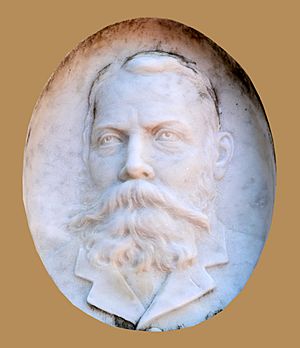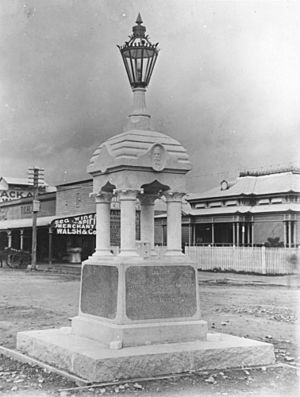Dr EA Koch Memorial facts for kids
Quick facts for kids Dr EA Koch Memorial |
|
|---|---|

Dr EA Koch Memorial in Anzac Memorial Park, 1996
|
|
| Location | Abbot Street, Cairns, Cairns Region, Queensland, Australia |
| Design period | 1900 - 1914 (early 20th century) |
| Built | 1903 |
| Architect | Melrose & Fenwick |
| Official name: Dr EA Koch Memorial | |
| Type | state heritage (built) |
| Designated | 27 May 1997 |
| Reference no. | 601681 |
| Significant period | 1900s (fabric) 1903-c. 1970 (historical, first location) |
| Significant components | memorial - drinking fountain, lamp/s, sculpture |
| Lua error in Module:Location_map at line 420: attempt to index field 'wikibase' (a nil value). | |
The Dr EA Koch Memorial is a special monument in Cairns, Queensland, Australia. It honors Dr. Edward Albert Koch, a kind and skilled doctor. He was very important for treating tropical diseases in the late 1800s. People in Cairns built this memorial in 1903 to remember his great work. It is now listed on the Queensland Heritage Register.
Contents
History of the Memorial
Who Was Dr. Edward Albert Koch?
Dr. Edward Albert Koch was born in Germany in 1843. He studied medicine and became a doctor in 1870. After working in the army, he came to Queensland, Australia, in 1877. He started his own medical practice in Cairns in 1882. He also became a medical officer at the Cairns Hospital. Later, he took charge of the hospital.
Dr. Koch also worked as a surgeon for the Naval Brigade. He was a visiting surgeon for Cairns prison. He did these jobs without pay. He was known for his medical skills and his kindness to families in Cairns.
Fighting Tropical Fevers
Dr. Koch was especially important for treating tropical fevers. These included diseases like malaria and typhoid. These fevers were common in North Queensland in the 1880s. They affected miners, railway workers, and sugar plantation workers.
Dr. Koch was one of the first to understand that mosquitoes carried the malaria parasite. This was before scientists fully proved it. He created a special "fever mixture" to treat malaria. It contained quinine and sulphuric acid. This mixture was very effective. It was sold across North Queensland and in Papua New Guinea. It helped control malaria in Cairns before the Second World War.
Besides his famous medicine, Dr. Koch also taught people how to prevent malaria. He told workers to cover their arms in the evenings. He also visited sugar plantations to check on the health of the workers.
Building the Memorial
Dr. Koch passed away on June 28, 1901, at 57 years old. He was buried in the McLeod Street Pioneer Cemetery. To honor him, the people of Cairns raised money for a memorial. They wanted it to be beautiful and useful.
Messrs Melrose and Fenwick from Townsville designed the memorial. It was a drinking fountain with a gas lamp on top. It was placed in the middle of the intersection of Abbott and Spence Streets.
The memorial was about 14 feet (4.3 meters) tall. It had a dome supported by four marble columns. These columns came from Carrara, Italy. The base was made of granite from Mount Elliot, near Townsville. Two sides of the dome had sculptures of Dr. Koch.
The memorial was finished by June 1903. It was officially revealed by Sir Herbert Chermside, the Governor of Queensland. Over time, the lamps on top of the memorial changed. By the late 1940s, they were removed. The memorial stayed in the street until the mid-1960s. Then, it was moved to Anzac Memorial Park. It was moved again within the park in the mid-1990s.
What the Memorial Looks Like
The Dr EA Koch Memorial is in Anzac Memorial Park. It is near the corner of Abbott and Spence Streets. It stands in front of The Reef Hotel Casino.
The memorial has a rough granite base. On top of this is a polished granite base, about 1 meter (3.3 feet) high. Four marble columns stand on this base. They hold up a dome. Two sides of the dome have sculptures of Dr. Koch.
On the polished granite base, you can read this message:
Erected by citizens of Cairns and District to the memory of Dr Koch 1901.
Above the dome, there is a new lamp and fitting that looks like the original one. The area around the memorial is paved with red concrete blocks.
Why the Memorial is Important
The Dr EA Koch Memorial is listed on the Queensland Heritage Register. This means it is a very important historical site.
A Look into Queensland's Past
This memorial shows us how medicine developed in Queensland. It highlights Dr. Koch's work in treating malaria. It also shows his early understanding of how mosquitoes spread the disease. His fever remedy and prevention tips helped control malaria in North Queensland for many years.
Beautiful Design
The memorial also adds to the beauty of Anzac Memorial Park. Its design makes the area around Abbott and Spence Streets look special.
Connecting with the Community
This monument is important to the people of Cairns. It is a physical reminder of their city's history. It helps them feel connected to their past.
Honoring a Key Figure
The memorial also celebrates the life and work of Dr. Koch. He was admired and respected by people in the past. The memorial stands as proof of his importance in Queensland's history.




